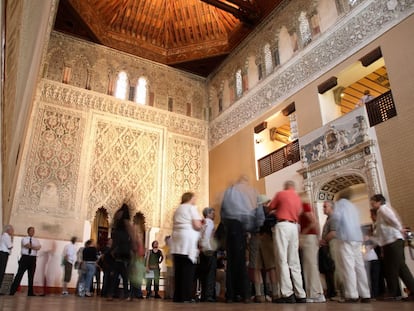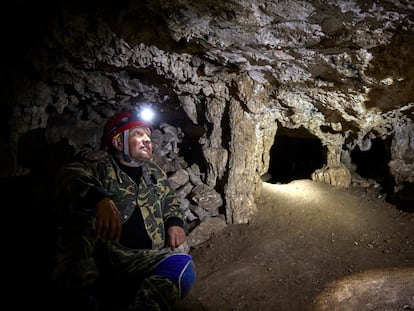Discovery of Tartessian sculptures turns study of Iberian pre-Roman culture on its head
Researchers have unearthed five stone busts dating from the 5th century BC at the Turuñuelo de Guareña archeological site in Badajoz, Spain

Every fresh discovery at the Casas de Turuñuelo archeological site in Guareña, Badajoz — where a huge 2,500-year-old two-floor building is being unearthed — makes it more difficult to sustain the accepted theory that the Tartessian culture that occupied the southwestern Iberian Peninsula between the 9th and 5th centuries B.C. was not a sophisticated civilization with its own entities. In addition to fabulous material riches — gold, bronzes and ivories — and constructive elements that were of the caliber of the most sophisticated of the time in the Mediterranean region, five unusual sculptures were recently uncovered.
The find constitutes the remains of five almost life-sized stone busts that not only provide a new twist in the investigation of the Tartessos, but also reveal for the first time faces that could resemble those of some of its people. The perfection in form that can be seen in two of the examples is not far from the best pieces that were produced in that era on the other side of the Mediterranean, in Greece and Etruria. Indigenous elements including earrings or arracadas (earrings with a hanging ornament) make these the first Tartessian sculptures discovered on the Iberian Peninsula dating from between the 5th and 4th centuries BC.
“Whether it was an artisan from elsewhere or someone born in the area who mastered the techniques, it seems clear that they were sculpted here, which also says a lot about the level of sophistication of those who commissioned something like this,” says Sebastián Celestino, a researcher at the Institute of Archaeology of Mérida and co-director of the project. After decades in which the only remotely similar sculptural expressions found at sites dating from the same era were small bronzes of Phoenician origin, “this breaks the paradigm that the Tartessian was an aniconic culture, that is, one that had no figurative or anthropomorphic representation.” Esther Rodríguez, the site’s other co-director, insists that the finding could also lead to the rewriting of art history, which mentions the flowering of sculpture in the Mediterranean region in Etruria and Greece, with the only Iberian exceptions being the Lady of Elche and the Lady of Baza, both of which date from around a century later than the Tartessian busts presented on Tuesday.
Regarding the earrings that two of the images on the busts are wearing, Rodríguez adds: “These types of earrings have been found at other sites of the era and region, so they are very well-documented, but now we finally know how they were worn: the chain was used to attach it to the ear.” Another of the busts depicts a warrior with a braid, a symbol of the transition to adulthood that was very common in the protohistory of the Iberian Peninsula. The researchers believe that the set of pieces, all of which have a flat back, were part of the same relief narrating a story involving, among others, this young warrior and, perhaps, the goddesses who protected him, represented by the two women with fuller faces.

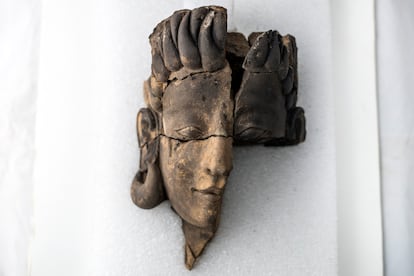
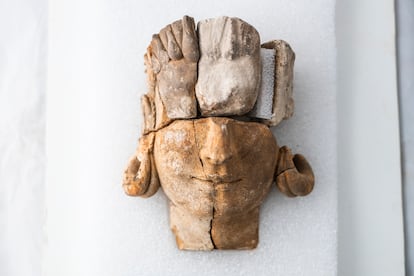
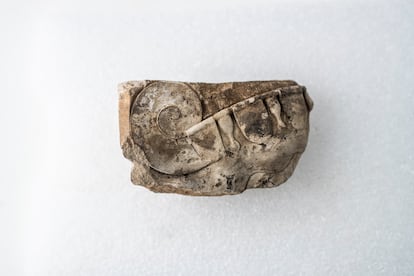

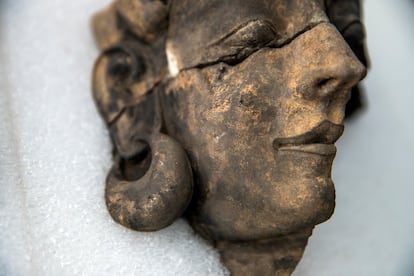
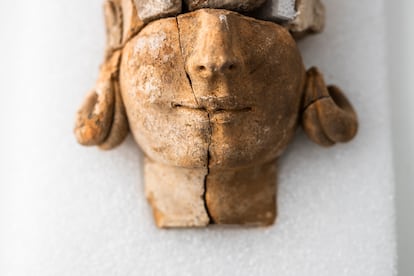
The sculptures were found scattered in one of the rooms that archaeologists unearthed during the excavation of this unusual building, which is unique in the western Mediterranean and continues to shed light on a civilization shrouded in mystery for many decades due to the scarcity of material remains for study. Researchers believe the room, surrounded by steps, could have had a public use, suggested by both the riches found within it and the level of organization required to build it, perhaps as an economic and political center.
In any case, the fact that the pieces were found in that room does not necessarily mean that the relief once adorned that space, because this building, like others in the area around the same time, was thoroughly destroyed: burned, buried and abandoned. In this case, after a great feast and the sacrifice of more than 50 animals, including horses, cows, pigs and a dog, which constituted the first hecatomb found in the Iberian Peninsula of a size comparable to the religious sacrifices described in the Old Testament and the Iliad.
Why one day, 2,500 years ago, the inhabitants of the Guareña site made the decision to destroy it is one of the great mysteries facing researchers. But in doing so, they unwittingly preserved the remains from the passage of time: the clay they used to bury it has acted as a kind of protective urn. The researchers have not ruled out the possibility that more pieces may yet appear as a result of the violent blows that were inflicted on them, which opens the door to the hypothesis that the destruction of the sanctuary was carried out by an external enemy, according to Rodríguez and Celestino.
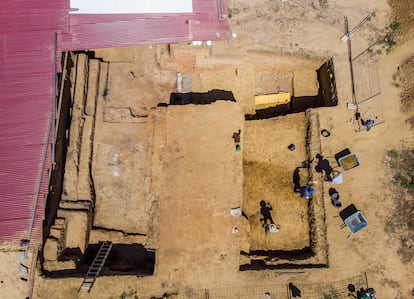
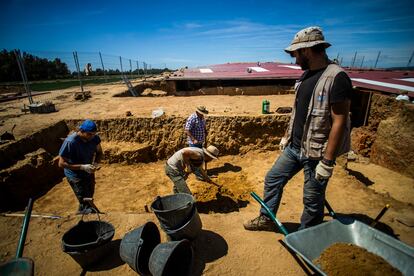
The sculptures are now being compared with the Etruscan, Iberian, and Greek sculptures of the time as nothing similar has ever been found before while researchers try to locate the stone used to make them, which is probably some kind of calcarenite, according to Rodríguez.
Work at the site has so far unearthed around 1,500 square meters of the estimated 8,000 square meters archeologists believe it may comprise, already providing many new clues to finally begin to understand the architecture, economy, social organization, and customs of the Tartessos, a civilization whose nucleus was located further south around Spain’s Guadalquivir River between Huelva, Seville and Cádiz.
In that region of southern Spain, from the 9th century B.C., the Tartessian culture was born as a result of the hybridization between the Phoenician colonizers and the local inhabitants, who prospered and became rich through the trade of metals. At some point during this process, the periphery of the Middle Guadalquivir Valley — where the most abundant Tartessian remains found to date are located — began to receive an influx of immigration from the central plains, perhaps due to some kind of crisis around the 6th century B.C., possibly economic, climatic, or a mixture of both, leading it to flourish to the point displayed by the Turuñuelo building.
The findings made so far, culminating with the five stone sculptures, underpin not only the idea of a Tartessian culture in its own right, but one of a sophistication comparable to the most advanced of the time throughout the Mediterranean region, say the researchers.
Sign up for our weekly newsletter to get more English-language news coverage from EL PAÍS USA Edition
Tu suscripción se está usando en otro dispositivo
¿Quieres añadir otro usuario a tu suscripción?
Si continúas leyendo en este dispositivo, no se podrá leer en el otro.
FlechaTu suscripción se está usando en otro dispositivo y solo puedes acceder a EL PAÍS desde un dispositivo a la vez.
Si quieres compartir tu cuenta, cambia tu suscripción a la modalidad Premium, así podrás añadir otro usuario. Cada uno accederá con su propia cuenta de email, lo que os permitirá personalizar vuestra experiencia en EL PAÍS.
¿Tienes una suscripción de empresa? Accede aquí para contratar más cuentas.
En el caso de no saber quién está usando tu cuenta, te recomendamos cambiar tu contraseña aquí.
Si decides continuar compartiendo tu cuenta, este mensaje se mostrará en tu dispositivo y en el de la otra persona que está usando tu cuenta de forma indefinida, afectando a tu experiencia de lectura. Puedes consultar aquí los términos y condiciones de la suscripción digital.
More information
Archived In
Últimas noticias
Maduro to be tried in the US for narcoterrorism and corruption
Maps of the US attack on Venezuela: Targets, airspace and deployed fleet
Venezuelans in exile: ‘This could be the end of a very dark chapter for Venezuela, but also the beginning of a time of uncertainty’
Key points of the military attack on Venezuela: Early morning bombings and a ‘captured’ president
Most viewed
- Alain Aspect, Nobel laureate in physics: ‘Einstein was so smart that he would have had to recognize quantum entanglement’
- David King, chemist: ‘There are scientists studying how to cool the planet; nobody should stop these experiments from happening’
- Mexico completes its trade shift with the entry into force of tariffs on China and countries without trade agreements
- Reinhard Genzel, Nobel laureate in physics: ‘One-minute videos will never give you the truth’
- Oona Chaplin: ‘I told James Cameron that I was living in a treehouse and starting a permaculture project with a friend’

